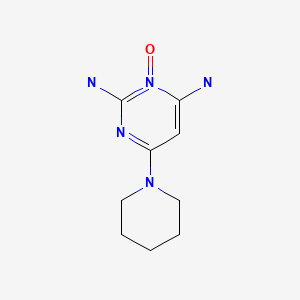Attribution Statement: LactMed is a registered trademark of the U.S. Department of Health and Human Services.
NCBI Bookshelf. A service of the National Library of Medicine, National Institutes of Health.
Drugs and Lactation Database (LactMed®) [Internet]. Bethesda (MD): National Institute of Child Health and Human Development; 2006-.
CASRN: 38304-91-5

Drug Levels and Effects
Summary of Use during Lactation
Because of the minimal amount of information on this potent agent, use minoxidil with caution, particularly when therapy involves a large maternal dosage or breastfeeding a newborn. Maternal topical minoxidil should pose low risk to older, full-term breastfed infants, but might best be avoided while breastfeeding a preterm or neonatal infant.
Drug Levels
Maternal Levels. In one case report, a 2-month-postpartum mother who was taking minoxidil 5 mg twice daily was given a, oral dose of 7.5 mg. The peak milk level of minoxidil plus glucuronide conjugate was 45.1 mcg/L at 1 hour after the dose. Milk levels paralleled serum levels, falling rapidly after the first hour to a concentration of 12.4 mcg/L at 3 hours, 4 mcg/L at 6 hours, 1.9 mcg/L at 9 hours, 0.8 mcg/L at 12 hours after the dose.[1]
Infant Levels. Relevant published information was not found as of the revision date.
Effects in Breastfed Infants
No hypertrichosis or other abnormal signs were seen in one infant breastfed (extent not stated) for 2 months of maternal minoxidil 5 mg twice daily by mouth. The mother was taking the drug throughout pregnancy and postpartum and the infant was born at 37 weeks of gestation.[1]
Another breastfed (extent not stated) infant who was born 4 weeks preterm developed facial hypertrichosis while her mother was using 5% minoxidil topically twice a day. The infant appeared normal at 2 weeks of age, but had considerable black hair on the forehead at 2 months of age. The mother discontinued minoxidil and at 6 months of age, the infant had lost the excess hair. The time course of minoxidil use and hair growth was not clearly specified in the report.[2] The reaction was possibly caused by minoxidil in milk, but no documentation of maternal or infant serum levels or milk levels was made and normal transient neonatal hypertrichosis is the possible cause.
Effects on Lactation and Breastmilk
Relevant published information was not found as of the revision date.
Alternate Drugs to Consider
References
- 1.
- Valdivieso A, Valdes G, Spiro TE, et al. Minoxidil in breast milk. Ann Intern Med 1985;102:135. Letter. PMID: 3966734. [PubMed: 3966734]
- 2.
- Trüeb RM, Caballero-Uribe N. Minoxidil-induced hypertrichosis in a breastfed infant. J Eur Acad Dermatol Venereol. 2022;36:e224–e5. [PubMed: 34657321]
Substance Identification
Substance Name
Minoxidil
CAS Registry Number
38304-91-5
Disclaimer: Information presented in this database is not meant as a substitute for professional judgment. You should consult your healthcare provider for breastfeeding advice related to your particular situation. The U.S. government does not warrant or assume any liability or responsibility for the accuracy or completeness of the information on this Site.
- User and Medical Advice Disclaimer
- Drugs and Lactation Database (LactMed) - Record Format
- LactMed - Database Creation and Peer Review Process
- Fact Sheet. Drugs and Lactation Database (LactMed)
- Drugs and Lactation Database (LactMed) - Glossary
- LactMed Selected References
- Drugs and Lactation Database (LactMed) - About Dietary Supplements
- Breastfeeding Links
- PubChem SubstanceRelated PubChem Substances
- PubMedLinks to PubMed
- Review Pyrimethamine.[Drugs and Lactation Database (...]Review Pyrimethamine.. Drugs and Lactation Database (LactMed®). 2006
- Overdose of Rogaine Extra Strength for Men topical minoxidil preparation.[J Toxicol Clin Toxicol. 1999]Overdose of Rogaine Extra Strength for Men topical minoxidil preparation.Farrell SE, Epstein SK. J Toxicol Clin Toxicol. 1999; 37(6):781-3.
- Review Fentanyl.[Drugs and Lactation Database (...]Review Fentanyl.. Drugs and Lactation Database (LactMed®). 2006
- Review Trimethoprim.[Drugs and Lactation Database (...]Review Trimethoprim.. Drugs and Lactation Database (LactMed®). 2006
- Metabolism of minoxidil, a new hypotensive agent II: biotransformation following oral administration to rats, dogs, and monkeys.[J Pharm Sci. 1975]Metabolism of minoxidil, a new hypotensive agent II: biotransformation following oral administration to rats, dogs, and monkeys.Thomas RC, Harpootlian H. J Pharm Sci. 1975 Aug; 64(8):1366-71.
- Minoxidil - Drugs and Lactation Database (LactMed®)Minoxidil - Drugs and Lactation Database (LactMed®)
Your browsing activity is empty.
Activity recording is turned off.
See more...
